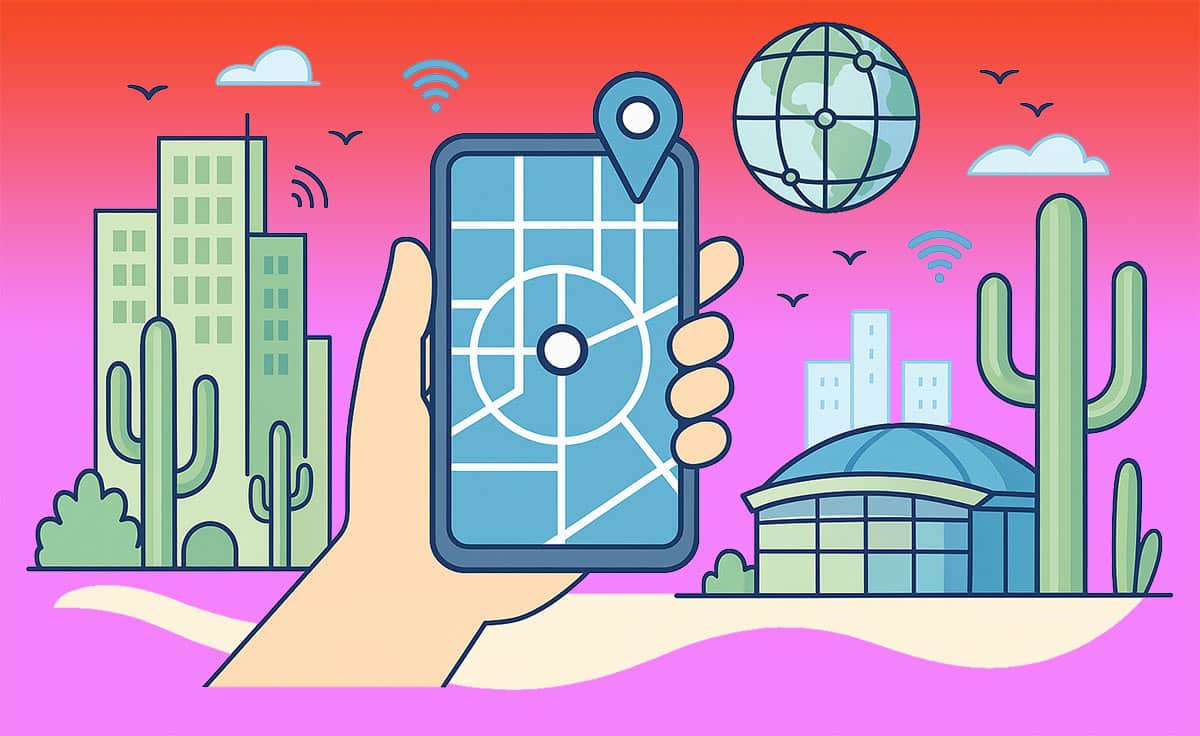How Geofencing Can Help Phoenix-Area Businesses Grow
Imagine this: a customer is walking down Main Street. Their phone buzzes with a special offer from a boutique just a few doors away. A few minutes later, they’re inside the store, making a purchase.
That’s geofencing at work. It connects local businesses to nearby people at the exact moment they’re most likely to act.
What is Geofencing?
Geofencing creates an invisible boundary around a physical location, like your business, a park, or even a competitor’s storefront or building. When someone enters that area with their smartphone, it triggers an action. Typically, that means they see an ad, an offer, or a helpful reminder about your business.
This lets local businesses focus their advertising efforts on real people who are nearby and ready to engage.
How Geofencing Works (Simple Overview)
Geofencing is surprisingly simple to implement. Here’s a quick breakdown.
- Pick your area: Like a one-mile radius around your storefront, a local venue, or a competitor’s business.
- Create and launch your ad: This might appear in apps, websites, or social media feeds.
- Convert awareness into action: The person visits your business, calls, or redeems an offer.
This is not just about showing an ad. It’s about showing the right ad to the right person at the right time.
Why Phoenix Businesses Love Geofencing
For businesses in Phoenix, Scottsdale, Glendale, Tempe, and surrounding areas, geofencing provides some very practical benefits.
- Smarter targeting: You’re not spending ad dollars on people across the state.
- More attention: Location-based ads feel relevant and tend to get more clicks.
- Better use of your budget: Since you’re focusing on people who are nearby, your ads go further.
- Increased foot traffic: Timely, compelling offers delivered while someone nearby can nudge them to walk in.
Real Examples of Geofencing in Action
Wondering how this might apply to your business? Here are a few Phoenix-area geofencing use cases:
- Happy Hour Promos
Restaurants near downtown offices can target workers between 3 and 6 PM with Happy Hour specials. - Event-Based Ads
Retailers can geofence large events at Footprint Center or Tempe Marketplace to pull in nearby attendees. - Competitor Targeting
A boutique in Old Town Scottsdale can place a geofence around a national chain nearby, offering something more unique or personal. - Holiday or Seasonal Campaigns
A toy store in Ahwatukee could geofence the local mall in December with “Avoid the lines and shop local” offers. - Dental Clinics
A dental office in Chandler could geofence pediatric clinics or family event spaces and offer free consults for parents looking for a new provider. - Medspas and Aesthetic Clinics
Medspas in Scottsdale could geofence high-end salons or dermatologist offices and promote Botox specials, skin treatments, or new client offers. - Hair and Nail Salons
A local salon could geofence around a beauty supply store, mall, or nearby competitors and advertise “Same-day Appointments Available” or seasonal styles. - Healthcare Providers
Chiropractors, physical therapists, and urgent care clinics in the Valley can geofence gyms or wellness expos and promote free injury screenings or consultations. - Home Services
HVAC, plumbing, and pest control companies can geofence neighborhoods or new construction areas and show local ads like “Now servicing your area.” - Pet Services
A pet groomer in Peoria might geofence dog parks, vet clinics, or pet supply stores with messages like “Get your pup ready for the weekend!” - Real Estate and Property Managers
Agents can geofence apartment complexes or open houses nearby and offer free home value reports or exclusive listings. - Auto Repair and Tire Shops
A car shop in Mesa could geofence used car dealerships or emissions testing centers, targeting drivers with offers like “$25 Off Your Next Oil Change” or “Free Brake Inspection While You Wait.” - Local Coffee Shops
An independent coffee shop near ASU in Tempe could geofence student housing or rival chains like Starbucks, offering “10% Off with Student ID” or “Free Espresso Shot Before Finals.” - Law Firms and Legal Services
A personal injury attorney in Phoenix could geofence urgent care centers, ERs, or auto body shops and serve ads like “Injured? Talk to a local attorney for free” to reach potential clients at just the right time.
Geofencing gives Phoenix businesses the ability to think strategically and locally at the same time.
Are Geolocation Marketing and Geofencing the Same Thing?
Not exactly, but they’re closely related.
Geolocation marketing is the broader term. It refers to any marketing strategy that uses a customer’s physical location to deliver targeted content, messages, or offers. This can include things like:
- Location-based search ads
- Google Business Profile suggestions
- Personalized email or app messages when someone visits a location
- Weather-based or regional promotions
Geofencing, on the other hand, is a specific type of geolocation marketing. It uses a virtual boundary around a physical area, like your storefront, a competitor’s location, or a busy event, to trigger a mobile ad or alert when someone enters that area with their smartphone.
How to Get Started with Geofencing
Here’s what you need to know to begin.
- Choose your target area: Think about where your potential customers are already spending time.
- Craft a clear message: This might be an offer, a limited-time promotion, or even an event announcement.
- Measure results: Watch your ad impressions, clicks, and conversions. Make small changes if needed.
You can run geofencing campaigns on some ad platforms, but most local businesses benefit from working with a digital marketing agency that already knows how to set it all up and optimize it.
FAQs About Geofencing for Phoenix-Area Businesses
What kinds of businesses should use geofencing?
Retail shops, restaurants, gyms, salons, clinics, real estate offices, and more. If you rely on local traffic, geofencing can work for you.
How big should my geofence be?
One to five miles is typical for most urban areas. In suburban areas, you might expand a bit depending on traffic flow.
Do the ads only appear in apps?
No. They can show up in apps, mobile websites, social media, and sometimes even Google’s Display Network.
Is geofencing expensive?
No. It’s often more affordable than traditional ads because you’re not wasting impressions on the wrong audience.
Can I geofence my competitors?
Yes, and many smart businesses do. It’s called “conquesting.” You serve ads to people who are visiting a competitor and offer them a better deal.
How do I know it’s working?
You’ll see results in your ad dashboard: impressions, clicks, store visits, and offer redemptions can all be tracked.
What’s the difference between GPS tracking and geofencing?
Geofencing is about delivering ads to people who enter a zone. It doesn’t track their movements or store personal data. GPS tracking is used for navigation or logistics, not marketing.
Does geofencing pair well with SEO?
Yes. Geofencing and SEO can work together to boost local visibility and engagement. SEO helps your business get discovered when people search online, while geofencing captures their attention when they’re physically nearby. For example, someone might find you on Google during a search, then later see a geofenced ad when they’re close to your location. Combining both gives you more opportunities to stay top of mind and convert leads into customers.
Final Thoughts
Geofencing offers Phoenix-area businesses a smarter way to advertise. You’re reaching the right people when it matters most – while they’re close, interested, and able to act.
If you’re looking for help building a hyperlocal marketing strategy that combines geofencing with smart SEO and content, our team at Accelerated Web Systems can help. We’re a Phoenix Web Design and Digital Marketing Agency with 20+ years of experience helping businesses grow.


